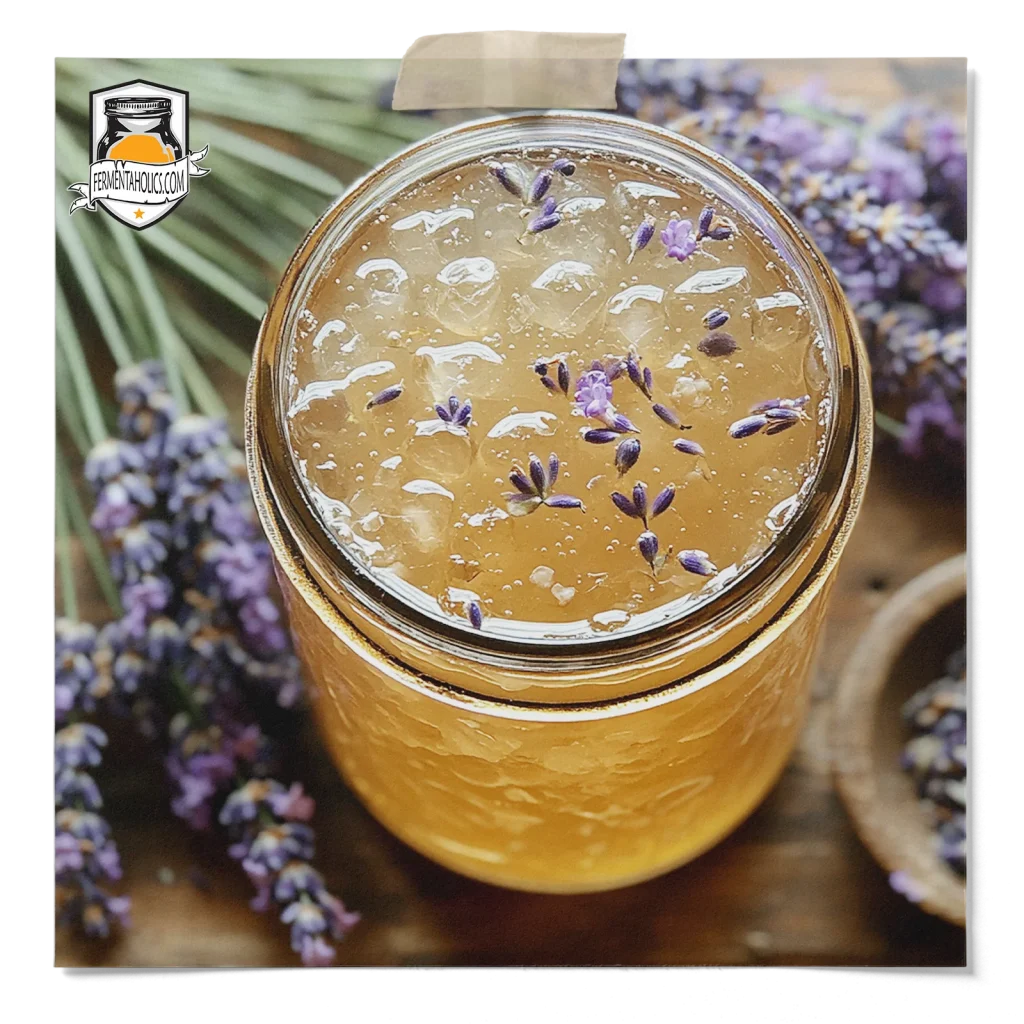
Enjoying a glass of kombucha is often a ceremonious event in my day, something to look forward to. The different flavors and aroma of each kombucha contribute to this experience in their own ways. Lavender Kombucha is calming, grounding, and allows me to re-set to a positive mindset. Be sure to pour this into a glass before enjoying to maximize its aroma therapeutic effects.

It’s important to note that making homemade kombucha is almost always a two-step fermentation process. Brewing kombucha is only a one-step process for those who prefer an unflavored flat kombucha. Otherwise, the steps consist of a primary fermentation and a secondary fermentation.
Primary fermentation is the first step of the kombucha brewing process. This is where your SCOBY transforms regular sweet tea into the tart and slightly sweet kombucha we love. At the end of this stage, you will have finished kombucha, but it will be flat and unflavored. Have you skipped this step? Then check out our guide on how to make kombucha at home, and for jun kombucha, see our post on how to make jun kombucha tea at home. Traditional kombucha is going to yield a bolder brew, while jun kombucha is milder and can be a bit tarter.
Secondary fermentation is the step where you bottle, carbonate, and flavor your kombucha with the addition of sugar and flavors. In this step, the finished kombucha from the primary is mixed with sugar, fruits, or other flavors before bottling it with specialized lids that can hold pressure, like flip-top bottles. The bottled kombucha is then left at room temperature for natural fermentation, where yeast carbonates the kombucha within the sealed bottle. The ideal temperature range for this process is between 75-85°F. The amount of time needed to carbonate within the bottle is highly tied to temperature, which can take anywhere from 2-10 days.
💡Since this recipe is for the secondary fermentation, to make this recipe, you’ll need to have kombucha that has finished the primary fermentation and is ready to bottle.
This recipe makes one 16-fluid-ounce bottle. A 1-gallon batch of kombucha will make seven 16-ounce bottles, so for one gallon, you will need to multiply the ingredients by 7. Before beginning this recipe, you will need to:
16 FL Oz Bottles
20
Minutes2-10
DaysThis lavender kombucha recipe is for one 16 fluid ounce bottle. For a gallon batch, make seven bottles. To scale this recipe to a gallon batch, multiply the ingredients by seven. Before bottling your kombucha, remove the SCOBY pellicle along with 12-16 ounces of kombucha starter tea from your brew, and reserve for your next batch.
16 Oz Kombucha from a completed primary fermentation.
1 TBSP Dried Lavender Flowers
4 Oz Water
1/2 TSP Honey
16 Oz Swing Top Bottles
Strainer – Optional
Tea steeping vessel – This can be a tea ball, reusable tea bag, cheesecloth, or a strainer (any way to brew loose leaf tea)
Bring water to a boil in a small pot. Remove from heat.
Steep lavender until the liquid is cooled, about 10-15 minutes.
Remove lavender, stir in honey and pour the concentrated tea into a clean 16 oz bottle.
Fill each bottle with kombucha, leaving about 1 to 2 inches of head-space. Tightly place the caps on each bottle.
Keep bottles at room temperature for 2-10 days; it will carbonate faster at higher temperatures and slower when cold.
Once per day, you’ll want to burp the bottles. This is done by removing the cap to allow built-up pressure to escape then placing the cap back on. As soon as you put the lid back on, the carbonation will begin to build back up, so no worries about it getting flat. Try not to skip this, or you may get kombucha all over your face when you do go to open it or, worse yet, a bottle bomb.
Chill in the refrigerator once you’re happy with the carbonation levels. Based on preference, you can serve as is or strain before drinking.
